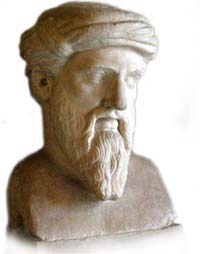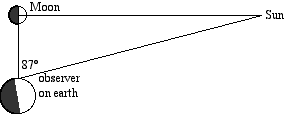![]()
![]()
Thales of Miletos (b 624 BC, d 545 BC) was regarded as one of the Seven Wise Men of Ancient Greece! Thales believed that the earth was a disk floating on the world ocean, surrounded by the rotating celestial sphere carrying the stars and other heavenly objects. Legend (perhaps false?) has it that he predicted the loss of daylight (a solar eclipse) in 585 BC based on either Babylonian or Egyptian astronomical records and by doing so caused the end to the long war between the Lydians and Persians. Whether the legend was true or not, both the Babylonians and Egyptians did for many centuries made accurate records of such astronomic events and noted their periods of occurrence.
 The development of science and religion were parallel, contiguous, and interrelated in many ways. That development often took place in the same minds! Pythagoras (←statue at left, b 566 BC, d 497 BC), after studying perhaps with Thales then in Egypt and Babylon, developed a religious order in Croton which viewed the universe as a logically connected, knowable cosmos. The group chose to live very ascetic, austere, vegetarian lives, partially in response to their belief that human souls could inhabit other people or animals. Mathematics was an intimate part of their universe. They used an a priori scientific method which presumed how the universe must be arranged, then looked for confirming evidence. Their study of mathematics suggested the most perfect geometric shape was a sphere. So they presumed the earth and all the other major parts of the universe must be spherical. They then looked for supporting evidence:
The development of science and religion were parallel, contiguous, and interrelated in many ways. That development often took place in the same minds! Pythagoras (←statue at left, b 566 BC, d 497 BC), after studying perhaps with Thales then in Egypt and Babylon, developed a religious order in Croton which viewed the universe as a logically connected, knowable cosmos. The group chose to live very ascetic, austere, vegetarian lives, partially in response to their belief that human souls could inhabit other people or animals. Mathematics was an intimate part of their universe. They used an a priori scientific method which presumed how the universe must be arranged, then looked for confirming evidence. Their study of mathematics suggested the most perfect geometric shape was a sphere. So they presumed the earth and all the other major parts of the universe must be spherical. They then looked for supporting evidence:
So all peoples who learned from the Pythagoreans have known convincing evidence that the earth and all heavenly bodies are spherical. But the earth itself is not a perfect sphere. The Pythagoreans established a dualism where the celestial heavens were eternal, divine, perfect, and unchangeable with only perfect circular motion. The imperfect sublunar earth was endlessly changing, decaying, mortal, dying with irregular, capricious motions.
Plato, famous teacher in Athens, noted that planets seem to wander while all else in the sky moves in the uniform motion of a rotating sphere. He suggested that the planets must somehow also have perfect circular motion and probably challenged his students to save the phenomena
by determining the planets' true motions.
save the phenomena.
So the Greeks successfully explained the observed motions of all heavenly objects! As more accurate observation found small imperfections, they found additional spheres could be added to account for these details. What remained was for a complete cataloging of all stars, the determination of the sizes of each heavenly body, and their spacings.
hypotheses:[Actually only 1, 2 and 3 are hypotheses that contain assumptions; the others are the kind of careful observation and comparison we call measurements.]
From these measurements and assumptions, Aristarchos deduced the following:

While Aristarchos pioneered a procedure which we still find valid, we now know his measurements were inaccurate. The actual angle between the Moon and Sun at the time of Half Moon is about 89° 50'. And the Sun and Moon each subtend about 0.5° in the sky. Use these better measurements to recalculate the relative sizes and distances. It may be easier to use the law of sines which states the lengths of triangle sides are proportional to the sines of the opposite angles (a / sine A = b / sine B = c / sine C) rather than attempt to construct accurate scale triangles.
We note that the Greeks relied heavily on careful observations, the a priori method, and deductive logic to understand astronomy. These tools of science are still widely used today.
Finally, record your procedures, measurements, and findings in your journal. If you need course credit, use your observations recorded in your journal to construct a technical report.
![]()
next Experiment: Measuring the Size of the Earth
to ie-Physics menu
to site menu